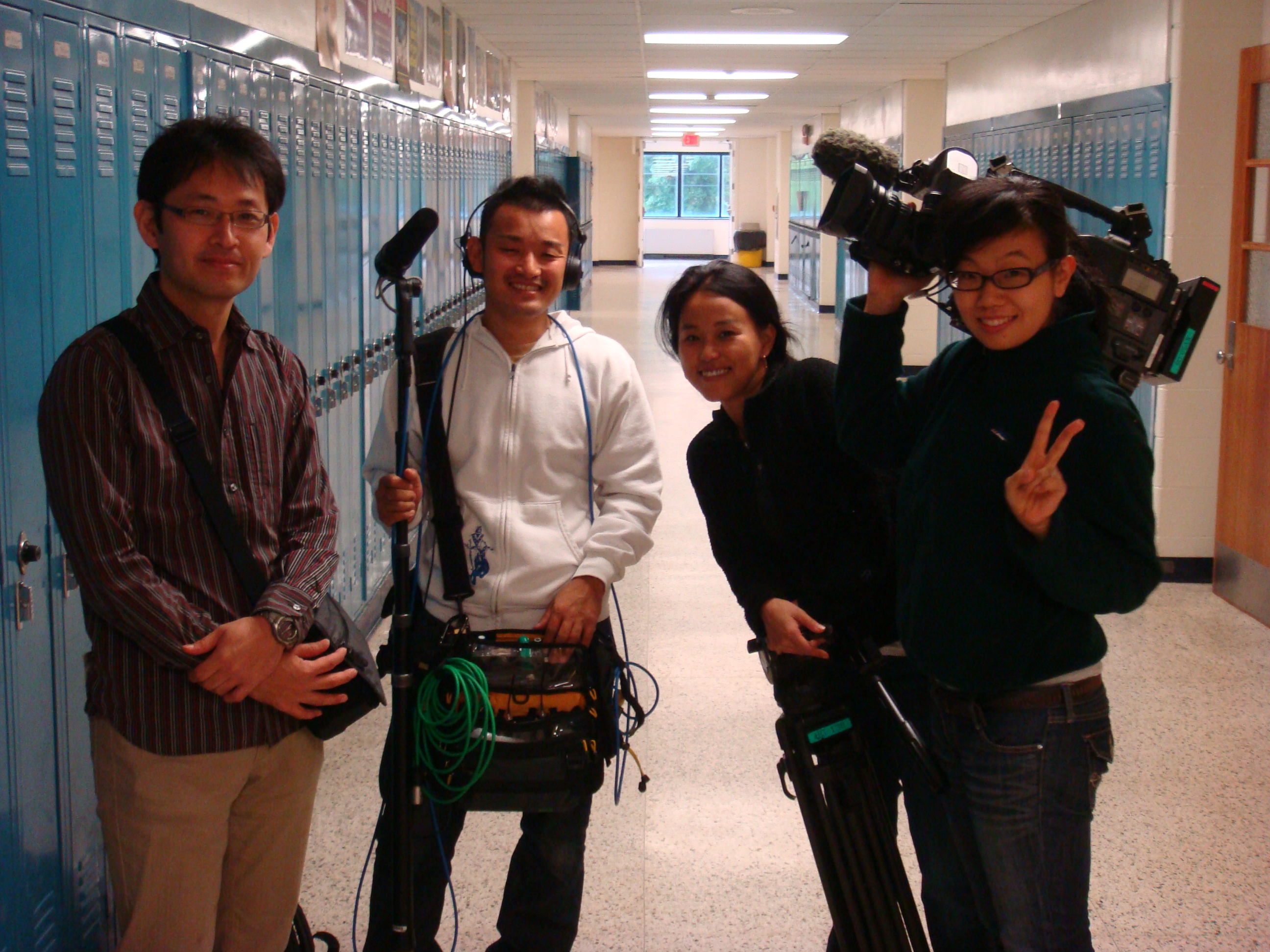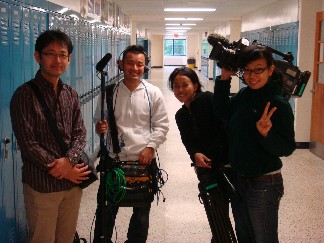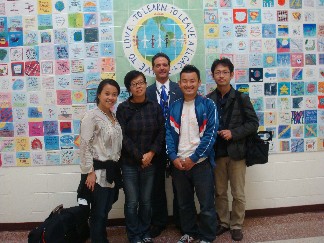We Survived a Japanese Film Documentary


By Frank Rudnesky, Ed.D.
They followed me around for a week and when they weren’t following me around, I followed them. A team of Japanese documentary filmmakers recently visited our school to do an exposé about technology integration in American classrooms. The 84 minute television show included comparisons to Japanese and American schools along with a panel of Japanese experts.
The film team was in our school for several days before I realized they all spoke English. Because everyone in their group spoke through an interpreter, I didn’t know they understood everything I said. How naïve was I? Probably, about as naïve as they were about technology integration. I found out that human nature has no barriers.
As I tried to explain more and more about the process of technology integration, I was able to reflect on how we started the whole process in a world where the digital natives (our students) have surpassed the digital immigrants (most teachers) in the acquisition of technology. As I examined our process, I also realized that what I was trying to explain to our new Japanese friends was similar to how I explained the process to late adopters of technology in the classroom.
I was sitting in my office in the beginning of August contemplating the start of my tenth season as principal of the Belhaven Middle School in Southern New Jersey. A call came through from a United States director of the largest Japanese television station, Nippon Hoso Kyokai, (NHK). It was later explained to me that NHK is the Japanese version of public television in America. Students often asked me what I did all summer, and I often replied, “Nothing.” This being the furthest from the truth but it was almost always met with a laugh or a smile. Well, now I had something to do.
I was quickly put in contact with an interpreter/director/coordinator of this project. She told me that they read about our school in several technology integration articles. One that they were most intrigued about was our use of the Nintendo Wii in classroom instruction. One of our teachers used the Wii last school year to instruct his students in physics. Another teacher uses the video game, Dance- Dance Revolution, in her physical education class.
Several lengthy phone conversations led to several lengthy email exchanges to describe the when, where, how, and why of what we did. They wanted to know more about the reluctance of teachers integrating technology rather than the process of how we started. Before they visited our school, they always brought our conversations back to the video games. I always brought my new acquaintances back to the beginning of our technology integration process to give them the reasons for using technology in the first place.
The Japanese film team was impressed with the fact that all of our classrooms included interactive white boards. It was a difficult task to explain the why and how we acquired the money to equip our classrooms at a time when our education budgets are flat or reduced and the average person bashes education without full knowledge of what we do. The abbreviated version of our funding solution is that we have an active education foundation, and we acquired our equipment through a combination of grants and creative budgeting.
Finally, I got through to the documentary team about why we would allow video games in the classroom. It lines up with our constructivist approach to use technology to differentiate, allow the students to think critically and problem solve while actively engaging them in the classroom through a variety of project-based assessment. It also supports teachers that are willing to take creative risks for better teaching and learning opportunities. As I escorted the documentary team around our school building, they quickly witnessed many more forms of technology integration other than video games. Believe me, that was the shortened version.
The long version includes a lot of education initiatives including the recent decision (dah?) for the state of New Jersey (that’s where we live), to join the partnership for 21st Century Skills. More information can be obtained at http://www.21stcenturyskills.org. Importantly for us, we discovered the same concepts ten years earlier, and we did not have a lot of catching up to do. Our school did not need an advocacy group to design skills that every child and adult need to survive in the next level of academia and the world around them. Our students are immersed in technology away from school. So common sense should tell educators that we need this same immersion in the classrooms along with the other core curriculum skills.
The Japanese team was under the impression that having equipment was integrating technology. Not true, but that thought process was not unlike the line of thinking of many late technology adopters. I explained that the process started for us with our human resources, and it’s the process of quality that we try to maintain as we continually fine-tune the process of integrating technology.
When we started taking technology integration seriously, about a decade ago, we made a lot of discoveries. The first was that the integration of technology needed to be in line with the other goals of our school. So we gathered stakeholders, came up with a vision and mission and never looked back.
We examined our equipment and connectivity, benchmarked our teachers, surveyed our teachers, and developed professional development that broke down common barriers of time and isolation. It sounds a lot easier than it was but we used a combination of small group, large group, mentoring, and offsite training to create as many onsite turnkey trainers as possible.
As I met the film crew at 7:00 am during the second week of September, the first thing I told them was that technology integration and leadership held a big connection in our school. Every teacher needs to be a leader along with every student. The leadership component of our school involves commitment and a lot of professional development.
As they followed me around, they noticed me picking up writing utensils I found on the ground (pencils and pens). They observed me speaking to students and students speaking to me. The Japanese contingent thought this was uncommon practice for a middle school principal. I responded, “Never ask anyone to do something you would not do.” This is basic leadership theory. If you take ownership in your environment, your environment will respond in a positive way.
The same is true for technology integration. I took the documenters to the auditorium and showed them my webpage on the big screen. It also gave me an opportunity to showcase what we can do with connectivity in a large room. I showed them the different components of the character videos and my newsletters available in print and in mp3 files. I showed them how parents can easily access my email and how I can send an email to all the parents connected to our school. This refers back to my earlier statement, “Never ask anyone to do something you would not do.”
If you expect teachers to have interactive websites that communicate clearly and promote anytime learning, then you need to expect the same from yourself. It is not essential that I learn every technology tool in our school but it is necessary for me to research and use the technology that empowers others to take creative risks. It is crucial that everyone takes a leadership role to allow us to investigate technology options that will make our educational process better. The same theory will allow students to take creative risks in the classroom and learn in a way that is best for them.
"If your actions inspire others to dream more, do more and become more, you are a leader."
-John Quincy Adams
I tried to set up a schedule of teachers’ classrooms for them to visit to get a diversified look at what we do and how we integrate technology. After they started to film, they became attracted to certain types of lessons, and they developed a story line around certain teachers. The students were excited to be a part of the film, and they were more than willing to contribute their thoughts.
The documentary team visited our gymnasium where physical education teachers use heart rate monitors and video games. They visited an art class that draws mosaic self-portraits by copying and pasting pieces of colors. They visited the hub of our school, our library/media center that houses a computer laboratory along with video editing stations and classrooms. They scheduled Spanish classes where the teacher uses an interactive student-response system. They were impressed with our algebra teacher who uses a networking system for graphing calculators that also acts as a student response system. They also had the opportunity to visit an Interactive Television (ITV) connection with NASA as part of our career exploration series.
My next task involved explaining that students have different ways of learning the same information, and that technology naturally differentiates instruction and learning while engaging our students. I gave examples of auditory and visual versus kinesthetic and combinations of these. Some of my new Japanese friends understood these concepts, and they even gave examples of their own learning styles.
We discussed how exemplary teachers will also differentiate according to ability and interest and how these methods were used in our technology integrated lessons in a seamless manner. All this occurred simultaneously while satisfying the New Jersey Core Curriculum Content Standards that include technology as a component.
Several years ago, our New Jersey Department of Education told educators to integrate technology skills across the curriculum rather than remotely in a computer laboratory. Before education was mandated, we knew this was the right thing to do. This method of integration took learning to higher levels. We have our computer teacher team-plan and team-teach with classroom teachers. When a student needs a skill to complete a technology integrated lesson, that skill is either taught or reinforced with another curricular area. This thought process allows a more hands-on constructivist environment, and it allows teachers to collaborate more in a seamless fashion. It also empowers students to become facilitators and active learners rather than passive listeners.
The director of the documentary wanted to interview and observe teachers at different stages in their careers. They wanted a teacher that was at or near the end of his/her career. When I introduced them to a sixth grade social studies teacher, the first question went straight to her reluctance of integrating technology. She told them that technology integration was not really a choice for teachers at our school, and at first she was apprehensive. She referred to the new teachers as “young guns”. Her observation was that the “young guns” were more easily immersed in this new teaching tool. She discovered that after she let go of her preconceived notions, she was able to use her colleagues to train her without ever leaving her classroom. This professional development brought her to new levels of teaching and consequently brought her students to a higher level of learning.
This teacher’s barriers were eradicated through one-to-one peer mentoring. This was complimented with other types of training that broke down traditional barriers and alleviated her fears. Her methodology changed, and she achieved a master of instructional technology degree. Wow! Her plethora of training enabled her to become a turn-key trainer for the rest of our staffulty (faculty and staff).
The Japanese crew filmed our sixth grade social studies teacher in action while she was integrating technology and simultaneously training a student teacher. This was previously not possible without the technology and without allowing her students to become active participants and facilitators. This exemplary teacher came to the realization that it was an asset to the class when students helped each other and their teachers.
The documentary filmmakers interviewed another teacher that was in her first year. This seventh grade science teacher was overwhelmed with a number of issues that are common to entry-level teachers. One component they admired was the collegiality that our professional development process fostered. The Japanese were amazed at the ability of colleagues to help one another when it came to the integration of technology.
I kept stressing again and again that the most important components of our technology integration revolved around leadership, planning, and professional development. Remember the leadership element of our early meeting? After our winter break, we have a full day in-service. We believe that lesson modeling is an excellent introduction to fully understanding the power of technology integration.
In the morning we have a “whet your whistle” session. Three teams teach a mini lesson with different forms of technology integration. After lunch, we set up three laboratory areas where teachers can choose what they want to learn from what they just saw. Our goal, in these two hour hands-on sessions is to have everyone leave with a tangible product that they can use in the classroom. If they walk away with something they can use immediately, they are connected to a new skill or tool. The same usually happens in the classrooms with the students.
Originally, the film crew wanted to stay for two days. Two days turned into a week of filming. They even went to a student’s house on the weekend to interview her and her parents. They were intrigued with our “anytime, anywhere” learning and the collaboration from home both with the students and teachers and the parents and teachers. I equated this process with the film crew’s initial research: They found out about our school over the World Wide Web. They contacted me with email several times with questions. They put together a film with a digital camera and completed the project with video editing software.
This process is similar to the way our students learn or reinforce their learning at home or when they are on a trip. They can contact their teachers on secure blogs or email to ask questions. They can do research or homework anywhere there is an Internet connection. They can compile, edit, revise, and submit their technology integrated projects. Likewise, teachers and parents interact about grades and expectations.
They were impressed with every aspect of what we were able to show them. I was impressed with the way they approached the project and how they were able to value our opinions. To tell you the truth, I missed them when they left.
This experience allowed us to reflect on how far we progressed as educators and what we have accomplished as a school. The documentary filmmakers allowed us to see ourselves through the eyes of the world. We were able to step back and look at our process. This is something we will continue to do as we fine-tune our technology integration process along with all of our goals and objectives. We will also take a look at the world around us as we continue this process.
Conclusion
• Create a plan and continually fine-tune the process.
• Share common goals and objectives.
• Diversify your professional development.
• Create as many onsite trainers as possible.
• Promote collegiality.
• Always look at different ways.
• Empower everyone to promote creative risks.
• Always allow follow- up training.
• If you are contacted by a Japanese film documentary team, approach them with an open mind and open arms.

Tools and ideas to transform education. Sign up below.
